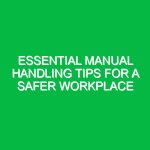Introduction
In today’s complex world, managing risks is not just a regulatory requirement but a vital element of ensuring the health, safety, and environmental (HSE) well-being of organizations and their stakeholders. The term “manage risks” encompasses a broad range of practices and strategies aimed at identifying, assessing, and mitigating potential Hazards that can impact health and Safety or the Environment. In HSE, these risks can stem from various sources, including workplace accidents, environmental contamination, and occupational illnesses. This article aims to explore essential strategies to manage risks effectively within the HSE domain, offering insights and practical tips for professionals seeking to enhance their risk management practices.
Understanding the Importance of Risk Management in HSE
Effective risk management is crucial for several reasons. Firstly, it helps organizations comply with legal and regulatory requirements, minimizing the likelihood of penalties and legal repercussions. Secondly, a robust risk management framework fosters a culture of Safety, enhancing employee morale and productivity. When workers feel safe, they are more likely to perform at their best. Furthermore, managing risks can lead to significant cost savings by preventing accidents and minimizing losses related to damages, healthcare, and legal fees. Ultimately, the goal is to protect people, property, and the planet.
Key Components of Risk Management in HSE
To develop a comprehensive strategy to manage risks in HSE, organizations should focus on several key components:
1. Risk Identification
The first step in managing risks is identifying potential Hazards. This involves reviewing processes, equipment, and environments to pinpoint possible sources of harm. Techniques such as job safety analysis (JSA), hazard identification checklists, and employee consultations can facilitate this process. For instance, a manufacturing plant may conduct a walkthrough to identify potential risks associated with machinery, chemicals, and ergonomics.
2. Risk Assessment
Once risks are identified, organizations must assess their potential impact and likelihood. This can involve qualitative methods, such as expert judgment, or quantitative approaches, such as statistical analysis. Tools like risk matrices can help visualize and prioritize risks based on their severity and probability. For example, a construction company may find that working at heights presents a high risk of severe injury, prompting them to prioritize Fall Protection measures.
3. Risk Control Measures
After assessing risks, organizations should implement Control Measures to mitigate them. These measures can be categorized into three tiers: elimination, substitution, and engineering controls. For instance, if a workplace hazard involves exposure to toxic chemicals, eliminating the use of those chemicals or substituting them with safer alternatives would be the most effective approach. If elimination is not possible, engineering controls such as fume hoods or proper ventilation can reduce exposure.
4. Training and Communication
Educating employees about risks and Safety Measures is vital for effective risk management. Training programs should be tailored to specific roles and include information on how to recognize hazards, use Personal Protective Equipment (PPE), and respond to emergencies. Open communication channels ensure that employees feel empowered to report hazards without fear of retribution. For example, regular safety meetings can provide a platform for discussing risks and solutions.
5. Monitoring and Review
Continuous monitoring of risk management practices is essential for their effectiveness. Organizations should regularly review safety protocols, incident reports, and employee feedback to identify areas for improvement. This iterative process ensures that risk management strategies evolve with changing workplace conditions and emerging threats. For instance, a healthcare facility may need to adjust its protocols in response to new infectious diseases or updated Regulations.
Real-Life Examples of Effective Risk Management
Real-world examples can provide valuable insights into effective risk management strategies. Consider the case of a large oil and gas company that faced significant challenges related to environmental spills. By implementing a comprehensive risk management program that included rigorous Training, regular drills, and advanced monitoring technologies, the company significantly reduced the frequency and severity of spills. This proactive approach not only protected the environment but also enhanced the company’s reputation and compliance with regulations.
Another example can be seen in the construction industry, where a major contractor adopted a behavioral-based safety program. This initiative encouraged workers to observe and report unsafe behaviors among their peers. As a result, the company saw a dramatic reduction in accidents and injuries, demonstrating the effectiveness of fostering a safety culture among employees.
Regulations and Standards Governing Risk Management in HSE
Various regulations and standards govern risk management practices in the HSE domain. Understanding these legal frameworks is crucial for compliance and effective risk management. Key regulations include:
- Occupational Safety and Health Administration (OSHA) Standards: These standards set forth guidelines for Workplace Safety and health, requiring employers to identify and manage risks effectively.
- Environmental Protection Agency (EPA) Regulations: The EPA enforces regulations related to environmental protection, compelling organizations to manage risks associated with pollution and hazardous waste.
- ISO 45001: This international standard outlines requirements for Occupational Health and safety management systems, emphasizing the need for effective risk management.
- ISO 14001: Similar to ISO 45001, this standard focuses on environmental management systems and encourages organizations to identify and manage environmental risks.
Organizations must stay informed about applicable regulations and standards to ensure compliance and enhance their risk management efforts. Non-compliance can lead to fines, legal issues, and reputational damage, making it imperative for businesses to prioritize risk management practices.
Best Practices for Managing Risks in HSE
To effectively manage risks in the HSE domain, organizations should consider the following Best Practices:
1. Foster a Safety Culture
Creating a culture of safety within the organization is paramount. This involves encouraging open communication, where employees feel comfortable reporting hazards and suggesting improvements. Leadership should model safety behaviors and recognize employees who prioritize safety.
2. Engage Employees in Risk Management
Involving employees in the risk management process can lead to more effective strategies. Workers who are actively engaged in identifying and addressing risks are often more aware of potential hazards and can contribute valuable insights based on their experiences.
3. Utilize Technology
Leverage technology to enhance risk management efforts. This can include software for tracking incidents, mobile applications for reporting hazards, and monitoring systems for real-time data collection. Technology can streamline processes and improve response times.
4. Conduct Regular Audits and Inspections
Regular audits and inspections help identify weaknesses in risk management strategies. These assessments should be documented, and findings should lead to actionable improvements. Continuous evaluation ensures that Safety Measures remain effective and relevant.
5. Stay Updated on Industry Trends
Keeping abreast of industry trends and emerging risks is critical. Subscribe to industry publications, participate in professional associations, and attend conferences to stay informed. Understanding new technologies, practices, and regulations can enhance an organization’s risk management capabilities.
Conclusion
In conclusion, effective risk management in the HSE domain is essential for ensuring the safety and well-being of employees, protecting the environment, and maintaining regulatory compliance. By embracing comprehensive strategies such as risk identification, assessment, and control measures, organizations can preemptively address hazards and mitigate their impacts. Furthermore, fostering a culture of safety and engaging employees in the risk management process can lead to more effective outcomes. As the landscape of health, safety, and environmental concerns continues to evolve, organizations must remain vigilant and adaptable in their risk management practices. Prioritizing these strategies not only promotes a safer workplace but also contributes to a sustainable future for all stakeholders involved.


